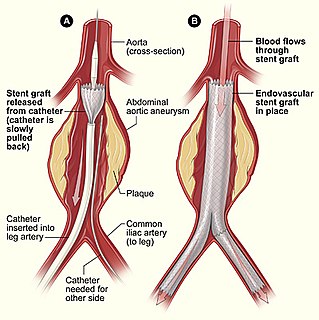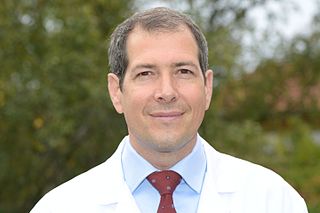Related Research Articles

Aortic insufficiency (AI), also known as aortic regurgitation (AR), is the leaking of the aortic valve of the heart that causes blood to flow in the reverse direction during ventricular diastole, from the aorta into the left ventricle. As a consequence, the cardiac muscle is forced to work harder than normal.

Interventional cardiology is a branch of cardiology that deals specifically with the catheter based treatment of structural heart diseases. Andreas Gruentzig is considered the father of interventional cardiology after the development of angioplasty by interventional radiologist Charles Dotter.

Mitral regurgitation (MR), mitral insufficiency, or mitral incompetence is a form of valvular heart disease in which the mitral valve does not close properly when the heart pumps out blood. It is the abnormal leaking of blood backwards from the left ventricle, through the mitral valve, into the left atrium, when the left ventricle contracts, i.e. there is regurgitation of blood back into the left atrium. MR is the most common form of valvular heart disease.
Aortic valve replacement is a procedure whereby the failing aortic valve of a patient's heart is replaced with an artificial heart valve. The aortic valve may need to be replaced because:
The intra-aortic balloon pump(IABP) is a mechanical device that increases myocardial oxygen perfusion and indirectly increases cardiac output through afterload reduction. It consists of a cylindrical polyurethane balloon that sits in the aorta, approximately 2 centimeters (0.79 in) from the left subclavian artery. The balloon inflates and deflates via counter pulsation, meaning it actively deflates in systole and inflates in diastole. Systolic deflation decreases afterload through a vacuum effect and indirectly increases forward flow from the heart. Diastolic inflation increases blood flow to the coronary arteries via retrograde flow. These actions combine to decrease myocardial oxygen demand and increase myocardial oxygen supply.
Valve replacement surgery is the replacement of one or more of the heart valves with either an artificial heart valve or a bioprosthesis. It is an alternative to valve repair.
Percutaneous aortic valve replacement (PAVR), also known as percutaneous aortic valve implantation (PAVI), transcatheter aortic valve implantation (TAVI) or transcatheter aortic valve replacement (TAVR), is the replacement of the aortic valve of the heart through the blood vessels. The replacement valve is delivered via one of several access methods: transfemoral, transapical, subclavian, direct aortic, and transcaval, among others.
Mitral valve replacement is a procedure whereby the diseased mitral valve of a patient's heart is replaced by either a mechanical or tissue (bioprosthetic) valve.

Endovascular aneurysm repair (EVAR), is a type of endovascular surgery used to treat pathology of the aorta, most commonly an abdominal aortic aneurysm (AAA). When used to treat thoracic aortic disease, the procedure is then specifically termed TEVAR for "thoracic endovascular aortic/aneurysm repair." The procedure involves the placement of an expandable stent graft within the aorta to treat aortic disease without operating directly on the aorta. In 2003, EVAR surpassed open aortic surgery as the most common technique for repair of AAA, and in 2010, EVAR accounted for 78% of all intact AAA repair in the United States.

Lutembacher's syndrome is a very rare form of congenital heart disease that affects one of the chambers of the heart as well as a valve. It is commonly known as both congenital atrial septal defect (ASD) and acquired mitral stenosis (MS). Congenital atrial septal defect refers to a hole being in the septum or wall that separates the two atria; this condition is usually seen in fetuses and infants. Mitral stenosis refers to mitral valve leaflets sticking to each other making the opening for blood to pass from the atrium to the ventricles very small. With the valve being so small, blood has difficulty passing from the left atrium into the left ventricle. Septal defects that may occur with Lutembacher's syndrome include: Ostium primum atrial septal defect or ostium secundum which is more prevalent.
David H. Adams is an American cardiac surgeon and the Marie-Josée and Henry R. Kravis Professor and Chairman of the Department of Cardiothoracic Surgery',' Icahn School of Medicine at Mount Sinai Hospital in New York City. Dr. Adams is a recognized leader in the field of heart valve surgery and mitral valve reconstruction. As director of Mount Sinai Mitral Valve Repair Center, he has set national benchmarks with >99% degenerative mitral valve repair rates, while running one of the largest valve repair programs in the United States. Dr. Adams is the co-inventor of 2 mitral valve annuloplasty repair rings (the Carpentier-McCarthy-Adams IMR ETlogix Ring and the Carpentier-Edwards Physio II Annuloplasty Ring, and is a senior consultant with royalty agreements with Edwards Lifesciences. He is also the inventor of the Tri-Ad Adams Tricuspid Annuloplasty ring with a royalty agreement with Medtronic. He is a co-author with Professor Alain Carpentier of the benchmark textbook in mitral valve surgery Carpentier's Reconstructive Valve Surgery. He is also the National Co-Principal Investigator of the FDA pivotal trial of the Medtronic-CoreValve transcatheter aortic valve replacement device.

Left atrial appendage occlusion (LAAO), also referred to as Left atrial appendage closure (LAAC) is a treatment strategy to reduce the risk of left atrial appendage blood clots from entering the bloodstream and causing a stroke in patients with non-valvular atrial fibrillation (AF).
Purshotam Lal is an Indian cardiologist and chairman and director of Interventional Cardiology of the Metro Group of Hospitals. He has been awarded the Padma Vibhushan (2009), Padma Bhushan, and Padma Shree. He specializes in non-surgical closure of heart holes (ASD/VSD), non-surgical replacement of valves, and treatment of multiple sclerosis.
Commissurotomy of heart valves is called valvulotomy, valvotomy, valvuloplasty, or valvoplasty and consists of making one or more incisions at the edges of the commissure formed between the two or three valve leaflets, which relieves the constriction of valvular stenosis.
Lars Georg Svensson is a cardiac surgeon and the chairman of the heart and vascular institute at Cleveland Clinic. He is the Director of the Aorta Center, Director of the Marfan Syndrome and Connective Tissue Disorder Clinic, and is a professor of surgery at Cleveland Clinic Lerner College of Medicine and Case Western Reserve University. He is also the Director of Quality Outcomes and Process Improvement for the Department of Thoracic and Cardiovascular Surgery and Affiliate Cardiac Surgery Program at Cleveland Clinic.
A hybrid cardiac surgical procedure in a narrow sense is defined as a procedure that combines a conventional surgical part with an interventional part, using some sort of catheter-based procedure guided by fluoroscopy imaging in a hybrid OR without interruption. A wider definition includes a clinically connected succession of a catheter intervention and a surgical procedure with a time gap.

Edwards Lifesciences is an American medical technology company headquartered in Irvine, CA, specializing in artificial heart valves and hemodynamic monitoring. It is most well-known for its SAPIEN transcatheter aortic heart valve made of bovine tissue within a collapsible stainless-steel stent, deployed via catheter. It is the first such FDA-approved, commercially-available device to replace a defective aortic valve without the need for open-heart surgery.

MitraClip is a medical device used to treat mitral valve regurgitation for individuals who should not have open-heart surgery. It is implanted via a tri-axial transcatheter technique and involves suturing together the anterior and posterior mitral valve leaflets. The guided catheter moves through the femoral vein to the right atrium and to the posterior, superior interatrial septum, using Fluorscopy and Transesophageal Echocardiogram or Trans Thoracic Echocardiogram.
Alain Cribier, M.D., FACC, FESC is a French interventional cardiologist, who is a Professor of Medicine and Director of Cardiology at the University of Rouen's Charles Nicolle Hospital. Alain Cribier is best known for performing the world's first transcatheter aortic valve implantation in 2002, the first mitral commissurotomy in 1995 and the first balloon aortic valvuloplasty in 1986.

Christoph Huber MD, FMH, FECTS is professor and Head of Division of Cardiac and Vascular Surgery at the University Hospital Geneva, Switzerland. He also maintains a research program, is an inventor, book author and entrepreneur, having founded the company Endoheart AG.
References
- ↑ Webb, John G.; Chandavimol, Mann; Thompson, Christopher (2006). "Percutaneous Aortic Valve Implantation Retrograde From the Femoral Artery". Circulation. 113 (6): 842–850. doi: 10.1161/CIRCULATIONAHA.105.582882 . PMID 16461813 . Retrieved 15 April 2015.
- ↑ Ye, Jian; Cheung, Anson; Lichtenstein, Samuel (4 May 2006). "Transapical aortic valve implantation in humans". The Journal of Thoracic and Cardiovascular Surgery. 131 (5): 1194–1196. doi:10.1016/j.jtcvs.2006.01.026. PMID 16678621.
- ↑ "First-in-human Tiara transcatheter mitral valve implantation successful". Healio. Retrieved 26 July 2017.
- ↑ "SFU" (PDF). SFU. SFU. Retrieved 15 April 2015.
- ↑ "John Webb, MD'82". UBC. UBC. Retrieved 15 April 2015.
- ↑ "John Webb, MD'82". UBC. UBC. Retrieved 15 April 2015.
- ↑ "Dr. John G. Webb M.D., FRCPC". Transcatheter Valve Interventions Inc. Transcatheter Valve Interventions Inc. Archived from the original on 26 April 2015. Retrieved 15 April 2015.
- ↑ Webb, John G.; Chandavimol, Mann; Thompson, Christopher (2006). "Percutaneous Aortic Valve Implantation Retrograde From the Femoral Artery". Circulation. 113 (6): 842–850. doi: 10.1161/CIRCULATIONAHA.105.582882 . PMID 16461813 . Retrieved 15 April 2015.
- ↑ Ye, Jian; Cheung, Anson; Lichtenstein, Samuel (4 May 2006). "Transapical aortic valve implantation in humans". The Journal of Thoracic and Cardiovascular Surgery. 131 (5): 1194–1196. doi:10.1016/j.jtcvs.2006.01.026. PMID 16678621.
- ↑ "Dr. John G. Webb M.D., FRCPC". Transcatheter Valve Interventions Inc. Transcatheter Valve Interventions Inc. Archived from the original on 26 April 2015. Retrieved 15 April 2015.